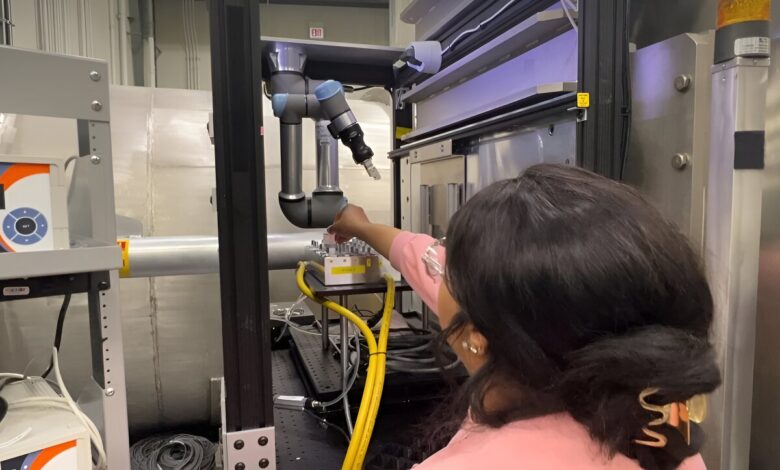Retrofitting robotics increases efficiency of neutron experiments

× close
Robots revolutionized the manufacturing industry by automating assembly lines. Now, more and more, they are being used to expedite the pace of scientific discovery.
Neutron scattering instruments are like giant high-powered microscopes that use beams of neutrons to study materials at the atomic scale. The BIO-SANS instrument, located at Oak Ridge National Laboratory’s High Flux Isotope Reactor, or HFIR, is the latest neutron scattering instrument to be retrofitted with state-of-the-art robotics and custom software.
The sophisticated upgrade quadruples the number of samples the instrument can measure automatically and significantly reduces the need for human assistance. BIO-SANS specializes in studying the behavior, shape and size of complex biological materials.
“It’s a remarkable step forward in capabilities. The ability to analyze more samples means we’ll get better results,” said ORNL Group Leader Mark Loguillo. “Not only that, but automation provides us with better time management which, in turn, allows us to make more measurements in an experiment than we could before.”
Installed on BIO-SANS is the UR5E Universal Robot, a lightweight mechanical arm equipped with five highly articulating joints. The robot is affixed to the ceiling inside an aluminum frame that contains a platform for storing experimental samples. Grippers attached to the end of the arm act like fingers that grab samples—powders or liquid solutions stored inside small metal canisters a couple cubic inches in size.
The robot moves samples to and from a tray directly beneath it and positions them into a beam of neutrons for analysis. About 84 samples can be stored inside the sample enclosure at a time. The robot can operate nonstop as long as the sample tray is full, which is one of the only parts of the experiment that requires human assistance once the experiment begins. Researchers can collect their data and monitor their experiment from their office or home.
“When the COVID-19 pandemic hit, we knew we needed a way to automate experiments so that they could be done remotely,” said Loguillo. “We installed a prototype robot that clearly demonstrated the value of integrating robotics and the potential it had, but eventually the prototype suffered from reliability issues. The new industrial-grade robot is highly customizable, which allows us to continue making improvements to its software and capabilities.”
Plans are in development to outfit the robot with artificial intelligence that will help reduce the time it takes for each experiment by eliminating unnecessary measurements. In turn, future upgrades will enable BIO-SANS to accommodate more complex experiments and increase scientific productivity.
In addition to Loguillo, team members involved with the project include ORNL researchers Mariano Ruiz-Rodriguez and John Wenzel. Based on the robot’s success, the team plans to upgrade other instruments, such as GP-SANS at HFIR and the MANDI diffractometer at the Spallation Neutron Source, or SNS.



